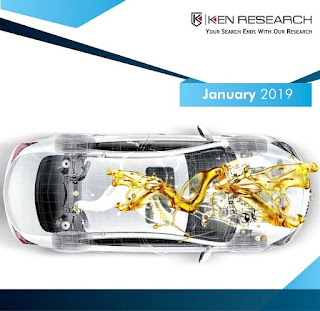The
report titled “Algeria
Lubricants Market Outlook to 2022 – By Automotive (Heavy Duty Diesel Engine
Oils, Passenger Car Motor Oils, Hydraulic Oils, Greases, Gear Oils and
Transmission Fluids) and By Industrial (Hydraulic Oils, Industrial Gear Oils,
Turbine Oils, Compressor Oils, Greases and Transformer Oils)”
provides a comprehensive analysis of the lubricants market in Algeria. The
report also covers the overall market size in terms of volume and value, segmentations
on the basis of origin, type, end user applications and channels of distribution
for lubricants, trade scenario, trends and developments, issues and challenges,
decision making criteria for end users, government regulations and guidelines, SWOT
analysis, competitive scenario, company profiles and best selling products. The
report concludes with future projections and analyst recommendations
highlighting the major opportunities and cautions for the lubricants market.
Algeria Lubricants Market Overview: Algeria lubricants market is presently in its growth stage.
The market comprises of both domestic production and import of lubricants to
meet the domestic demand for lubricants. There are 9 players in total that
operate in the organized space including the government owned Sonatrach. The
terrorist attacks near oil refineries in 2013 and the oil price shock during
2014-2015 negatively impacted the market during the period 2012-2017. However,
increasing government expenditure to diversify the oil dependent economy
through initiatives like National Vision 2030 and SH2030 are expected to keep
the overall demand for lubricants growing in future. The lubricant sales in
Algeria have declined at a negative CAGR during the period 2012 to 2017.
Algeria Lubricants Market Segmentation:
By Origin (Mineral, Semi-Synthetic and Synthetic Lubricants):
In 2017, mineral lubricants dominated the overall sales for
lubricants in Algeria. This is mainly due to their low retail price and easy
refining process. This was followed by semi-synthetic and synthetic lubricants,
which accounted for the lower volume share due to comparatively narrower scope
of usage in end user applications.
By Type (Automotive and Industrial): Automotive lubricants dominated the market till 2017 with
high volume of domestic sales in the country. They are required for rented,
used and pre-owned vehicles. Industrial lubricants followed with a comparatively
lesser volume share with construction sector being the largest end users. The
remaining end users of industrial lubricants include manufacturing, power
generation and other end user industries.
Algeria Automotive Lubricants Market Segmentation:
By Application (Heavy Duty Diesel Engine Oils, Passenger Car
Motor Oils, Hydraulic Oils, Greases, Gear Oils and Transmission Fluids): Domestic sales of Heavy Duty Diesel Engine Oils and Passenger
Car Motor Oils dominated the automotive lubricants market in Algeria catering
to majority of the market demand in 2017. The volume shares of Hydraulic Oils,
Greases and Gear & Transmission Fluids were much lesser and collectively
accounted for remaining volume share in the market.
By End Users (Passenger Vehicle Lubricants, Commercial
Vehicle Lubricants, Marine Lubricants and Aviation Lubricants): Commercial and passenger vehicles were the largest consumers
of automotive lubricants in Algeria during 2017 and collectively accounted for
majority of the market. This is due to the growing transportation and logistics
industry and high existing domestic demand in households. The remaining volume
share was of marine and aviation lubricants which were mostly imported from
abroad.
By Channel of Distribution (OEM Workshops/Service Stations,
Dealer Networks and Others): Dealer
networks were the leading category under this segmentation with the highest volume
share in 2017. This was mainly because of their expertise and knowledge which
enables them to advice customers. This increases customer trust and makes
dealer networks a preferred channel for sales. Service stations accounted for
the second highest market share in 2017. The remaining market was catered by
other channels such as supermarkets and online sales.
Algeria Industrial Lubricants Market Segmentation:
By Application (Hydraulic Oils, Industrial Gear Oils, Turbine
Oils, Compressor Oils, Greases and Transformer Oils): Hydraulic Oils were the leading category with maximum share by
volume in the market in 2017. This is due to their extensive usage in heavy
machineries with hydraulic systems. Industrial Gear Oils, which are widely used
in machineries operating under extreme temperature pressure, held the second
highest share. This was followed by Transformer Oils and Greases. Compressor
Oils and Turbine Oils held the lowest market shares because of fairly limited
areas of application.
By End Users (Construction, Power Generation, Manufacturing
and others): In 2017, construction
sector witnessed the maximum consumption of lubricants in Algeria as it
involves maximum usage of heavy machinery. The second and third highest market
shares were of power generation and manufacturing sectors respectively. Power
Generation sector primarily uses transformer oils and engine oils. The least
share in the market was held by other industries like plastics, textile,
pharmaceuticals and more.
Competitive Landscape: The competition in Algeria lubricant
market is fairly concentrated. At present, the
lubricants market in Algeria consists with 9 major players in the organized
sector dominating the market. Among these, 3 companies account for almost
entire volume share of the market. The government owned Sonatrach was the
market leader in 2017 followed by Total, Petroser, Shell, Exol, Rebex, Lincoln,
Liqui Moly and Bardahl. Competing parameters in the market include number and
type of product variants, application areas and channels of distribution.
Algeria Lubricants Market Future Outlook:
The
lubricant market of Algeria is expected to grow at a positive CAGR during the
period 2017 to 2022. This is primarily due to increasing government expenditure
on infrastructure, health, tourism and other industries. The five year plan of
government for the period 2015-2019 will witness an exorbitant investment of
USD 262 billion into the Algerian economy to boost the non-oil sectors of the
country which is expected to make industrial lubricants, the dominating
category by 2022. Among industrial lubricants, the demand for lubricants in
construction sector is expected to be the highest followed by power generation
and other sectors like plastics, textile and pharmaceuticals. The volume share
is expected to be the least for manufacturing sector in 2022.
Key Segments Covered:-
By Origin (Mineral,
Semi-synthetic and Synthetic Lubricants)
By Type (Automotive and
Industrial Lubricants)
Automotive Lubricants
By Application (Heavy
Duty Diesel Engine Oils, Passenger Car Motor Oils, Hydraulic Oils, Greases, Gear
Oils and Transmission Fluids)
By End Users
(Passenger Vehicle Lubricants, Commercial Vehicle Lubricants, Marine Lubricants
and Aviation Lubricants)
By Channel of Distribution
(OEM Workshops/Service Stations, Dealer Networks and Others)
Industrial Lubricants
By Application
(Hydraulic Oils, Industrial Gear Oils, Turbine Oils, Compressor Oils, Greases
and Transformer Oils)
By End Users (Construction,
Power Generation, Manufacturing and Others)
By Channel of Distribution
(Direct Sales by Companies and Workshops, Dealer network)
Key Target Audience:-
Lubricants Manufacturers
Lubricants Distributors
Government Agencies
Base-oil Companies
Additive Companies
Refining Companies
Time Period Captured in the Report:-
Historical Period: 2012-2017
Forecast Period: 2018-2022
Companies Covered:-
Sonatrach
Total S.A.
Petroser
Royal Dutch Shell
Exol Lubricants
Rebex Lubricants
Lincoln (SKF)
Liqui Moly
Bardahl
Key Topics Covered in the Report:-
Executive Summary
Research Methodology
Stakeholders in Algeria Lubricants Market
Algeria Lubricants Market Overview and Genesis
Value Chain Analysis for Algeria Lubricants Market
Algeria Lubricants Market Size
Algeria Lubricants Market Segmentation
Algeria Automotive Lubricants Market Segmentation
Algeria Industrial Lubricants Market Segmentation
Trade Scenario in Algeria Lubricants Market
Trends and Developments in Algeria Lubricants Market
Issues and Challenges in Algeria Lubricants Market
Decision Making Criteria for End Users in Algeria Lubricants
Market
Government Regulations and Guidelines in Algeria Lubricants
Market
SWOT Analysis for Algeria Lubricants Market
Competitive Scenario in Algeria Lubricants Market
Best Selling Products of Sonatrach, Total, Petroser and Shell
Company Profiles of Major Players in Algeria Lubricants
Market
Algeria Lubricants Market Future Outlook and Projections,
2017-2022E
Analyst Recommendations
For more information on the research report, refer to below
link:-
Related Reports By
Ken Research:-
Contact Us:-
Ken Research
Ankur Gupta, Head Marketing & Communications
Sales@kenresearch.com
+91-9015378249
Ken Research
Ankur Gupta, Head Marketing & Communications
Sales@kenresearch.com
+91-9015378249







